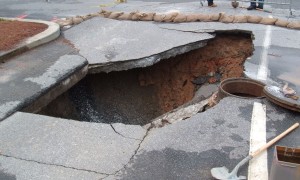The Power of Pressure Grouting
Sep 10, 2017Ground isn’t always stable enough to build on. Unfortunately, people do it anyway, and sometimes they end up with foundation problems down the line. Granted, the topic of foundation problems is a very complicated one, with varied causes:

Ground Composition
Sometimes certain ground is inherently more prone to stability issues than others; Alabama, Florida, Tennessee, Texas, Kentucky, and Missouri are the states where you’ll find this most.
Precipitation And Weathering
Sinkholes can form when rain water seeps down and loosens the already unstable earth below. They can also form when water drainage patterns change, and new drainage patterns develop. Sinkholes in Georgia are brought on by the slow, natural process of erosion in the underground limestone caves. While this erosion takes place over a period of thousands of years, when it reaches its climax, the land within a few hundred feet above the limestone collapses – sometimes very rapidly.
Human Activity
Substrata instability can occur from abandoned mines, as well as from errors in construction from civil engineers and foundation contractors.
Whatever the cause of your foundation problem, one of the most effective methods of fixing the foundation of an existing structure is pressure grouting.
Pressure grouting is a common foundation repair technique that involves pumping a cement mixture into the ground underneath a structure, to make the foundation on which it rests, more stable. Although pressure grouting is sometimes used to treat unstable foundations of buildings, it’s generally used in smaller foundation projects. Specifically speaking, the whole point of pressure grouting is to seal off bedrock and prevent soil from further seeping into the cavities made within it (also known as sinkholes). To explain further, pipes are injected deep into the earth, all the way down to the bedrock. They then carry the cement filling mixture until these cavities are filled. The depth at which the pipes must be pushed down, may vary quite a bit depending on the size of the structure, the nature of the soil, etc.
Pressure is another factor that tends to vary from project to project, and is determined by a pressure gauge (which is used between the concrete pump and the injection pipes). The mixture or grout is pumped into the pipes, while the structure at hand is closely analyzed for movement. Once the pressure reaches 300 psi (for example), the grout pipe is usually extracted in 5′ increments, the process then starts from the beginning, until the ground has been stabilized within about 10 feet of the surface.
Some critics of pressure grouting argue that it isn’t as effective a method of foundation stability as helical piering might be – which may explain why it’s sometimes more cost effective than its counterpart. Nevertheless, pressure grouting is the perfect foundation stability solution for concrete structures that aren’t raised. Helical piers can attach themselves to a building, but if you have a structure like a patio, this can become a bit more complicated, and many opt for pressure grouting in this circumstance.
If you’re in search of a foundation stability method for your sinkholes, etc, don’t hesitate to contact us. We’re your top of the line Atlanta pressure grouting contractors!

